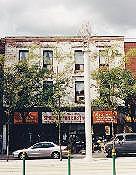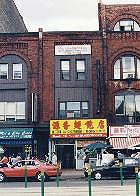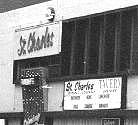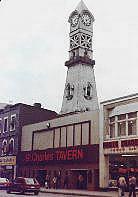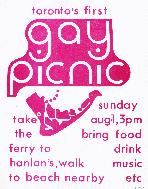|
Promiscuous |
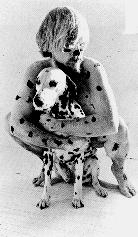
Reeely byootiful:
|
|
Spadina streetscapes
Spadina Avenue,
450 Spadina:
320 Spadina:
|
|
Bolter holes "You people are lucky to have a place."
The St Charles:
The Parkside:
|
1971
John Taylor was in photography at Ryerson Polytechnic Institute. In January 1971, after I had painted my apartment at 8A Grange but before I moved in, John, Flav and Frank, another friend, took it over as a photo studio.
I suppose it was all that white: they planned to cover Frank in flour, paint black dots on him and do a series of shots with his dog, a dalmatian. I wasn't thrilled, imagining black dots left all over, but I gave in. After John printed the pictures Flav told me they were "reeelly byootiful," as so much was to him. Seven of the shots were printed in image nation, published by the pioneering Coach House Press. Flav was right: they were beautiful.
This would become our pattern, his enthusiasm overcoming my usual caution and I, most of the time, happy enough that it did. In February we all went to a party, whose I didn't know. The host was Michael Pearl: I'd know him for years. It turned out he also knew many people I did. Joel was there, lots of Toronto Dance Theatre folks, and friends of theirs I'd soon know too. Even Martin Brenzell turned up (last I saw of him: in 1972, working in Israel, he went swimming and drowned).
And there was this fabulous little blond guy. The next day I wrote about all of it. Especially him.
- Sunday, February 21, 1971, 3 pm:
His name was Fred, or Fernando, or both. I heard him say to one of his friends after we had all been dancing: "That's the one I like," which was kind of cute. He introduced himself by offering me a bite of an apple while I was talking to his friend Julie, and later we all danced in a circle and otherwise hung around together.
I put on "Your Song" and he asked me to dance so we held onto each other and did. I later asked him home but he couldn't go, so I kissed him goodnight, rubbed his bottom (which was fine) and got a ride home from Joel.
I found out that I am not as sexually bashful as I had assumed I was, nor am I afraid to dance. It was all very good, unserious and loose, nice to have someone to kiss and hold onto on occasion without having to think much about it or confuse it for something else. It felt very good. Like his mouth and his bottom.
That first night with Fernando Salvagna (dancing to Elton John's first big hit) would become something else: a friendship made of occasional meetings. One would happen in Vancouver, at a club called Faces, Flav and I there in April 1973. We'd made a side trip to Seattle and in a bar there met a nice young man named Jim. He turned up at Faces, as did Fernando; we introduced them.
Jim and Fred would be together for years, back in Toronto. In time I slept with both -- just slept, each briefly staying with me when their relationship brushed the rocks. Such lovely men, particularly Fernando, so compact, succulent and alive. But he and I lost touch. Years later I would find him again, in a list of people by then dead.
Flav, John and I saw each other almost every day. They'd come down Huron to my place for baths; I would walk up to theirs for food, often hearty stir fries. More often we ate on Spadina: latkes at Switzer's Deli (with autographed shots of stars on it walls); blintzes, borscht, and 95 cent falafels at the Tel Aviv (its owner / host sometimes away: he was a reserve colonel in the Israeli airforce); banquet burgers at the greasy spoon Homestead.
Often we'd end an evening upstairs from one of those places, visiting Michael Thomas in his big flat near the Tel Aviv, Stanley Kochen and Paul Reuber in theirs over Switzer's, all of them training to be architects.
When not on Spadina we'd be found on Yonge. I was 21 by then, at last free to be a Good Boy gone Bad. Flav wasn't quite yet but it didn't matter: this was the year the drinking age would be lowered to 18 (later raised again, to 19). So there we were at The Parkside and, more rarely, The St Charles.
It's time I told you more about these notorious homo hangouts.
The St Charles was at 488, site from 1871 of Fire Station Number 3, with a tall clock tower. The firehall had been renovated beyond recognition but its tower remained, a local landmark. From the early 1950s it marked a Chinese restaurant.
The Parkside at 530 Yonge was a blank box, its facade masking any history. An archival photo likely from the late 1930s shows the Hotel Breadalbane -- which is it was -- with two storeys at the back, just one at the front, and signs for the same "Mens" and "Ladies" entrances we'd know years later.
Businessman Norman Bolter's family had owned the Breadalbane since 1945, when his father bought it. It remained a hotel -- its liquor license depending on that status: through its entire career as a gay spot there remained a few rooms at the back of its second floor. George Hislop, in his mid 40s then and the city's senior gay activist (I met him at The Parkside and have known him ever since) once told me that those rooms were home mostly to cab drivers.
By the time Flav and I knew them, The Parkside and The St Charles had been famously gay for some years, if less by conscious intent than circumstance. And the odd vagaries of legislation.
Beer had been on offer in tap rooms of Ontario hotels since 1934 (local prohibition, always spotty, having ended in 1927); in their restaurants both beer and wine. But serving harder spirits had been allowed only by the Ontario Liquor Licence Act of 1946-47, and only in designated "cocktail lounges." As Gerald Hannon would note in The Body Politic in 1980:
- "A province which had edged its way into a kind of lukewarm prohibition was now just about ready for a half hearted sophistication -- but, there were certain little class differences that were not about to be ignored. The working man went to beer parlours, and lest the working man miss his supper, spend his pay on a few too many drafts, wallop the wife and kids or, worst of all, be incapacitated for the next day's work, beer parlours simply closed their doors between 6:30 and 8 pm....
"Cocktail lounges, on the other hand, were imagined to attract patrons of a rather different order, and remained open even during that dangerous dinner hour."
The pioneer gay patrons of The St Charles had come as dinnertime vagrants, and from just across the street. The Hotel Torontonian had opened there in 1957, The Red Lion Room in its basement the usual hotel beer parlour, attracting the usual homosexual habitués. In its off hours they headed not home for supper, but across the street to 488 Yonge, under the clock -- for cocktails: the Chinese "family" restaurant there was licensed as a lounge.
The Torontonian became the Westbury; then a Howard Johnson's; then the Marriott Courtyard, that last incarnation masking its fine '50s modernism. But it still shares the block with another period classic, the City Park Apartments, three beautiful 14 storey slabs begun in 1954, marching east to Church Street.
City Park -- the first modern highrise housing in Toronto -- marked the dawn of massive residential construction in the area, offering sites even more vital to gay life than bars: lots of places where young, single people could afford to live. Even by 1971 more than half the area's 4,700 apartments housed only a single tenant, most under 40 and almost none with children. (For more on the nabe see a note below: "Gay downtown.")
City Park was soon dubbed "The Queens' Palaces." The Red Lion Room, soon full of queens too, got tagged "The Pink Pussy." By 1965 it had purred its last, sending the boys (butch and otherwise) in search of another local beer parlour. Just up the street, its tap room newly expanded, was The Parkside. And Norm Bolter let it be known he was willing.
His interest -- indicated then by no more than a wink and a nod; a decade later by his purchase of The St Charles -- was strictly business. "A gay person shouldn't own a place like this," he once said. "He'd get too emotionally involved."
Bolter's detachment was dramatically confirmed in The Parkside's basement. There he let police set up a spy post from which they could peer through a grill into the john next door to catch men having -- or even just hoping to have -- sex. It was long common to see cops dragging some forlorn guy up the stairs and out to a waiting cruiser.
That didn't stop until 1979, when the gay community, more organized by then, forced Bolter to evict the cops. At least from the cans: they were not infrequent visitors to the bar upstairs.
All bars are shaped by laws, The Parkside literally so (even upstairs). That Liquor Licence Act of 1946-47 had decreed segregated rooms: for men only, or for women with male escorts -- meant (like most booze legislation) to regulate morality. In this case to curb prostitution: "escorts" could not enter the ladies' side unless accompanied by, and later sitting with, a woman.
But it also created spaces exclusively for men. As George Hislop said, "that played right into our hands." Segregated licensing stopped in the '70s, but a few existing bars, The Parkside among them, were allowed to stay as they were.
Even the ambience of The Parkside's male only tap room was established in law: there was "not to be any obstruction preventing a full view of the entire room by anyone therein," likely to inhibit "gaming" or dope dealing (if the latter with little success). Open vistas amply abetted another vice: cruising -- except that no one but a waiter was allowed to stand up and walk around with a drink.
We all sat at little round tables covered in 25 cent glasses of draft, the only booze you could get. No one ever ordered by brand, you just said "two" or "four" or more and took whatever was on tap.
We had a full view indeed. If you saw someone enticing you might wait until he got up to go to the can -- so you could check him out on the way. You might follow him there, maybe timing your trip so you could bump into him as he came out. Or, if you had the nerve and he was sitting alone, you might go ask him to come join your table.
The place had its own distinct life -- if nearly the only public life we were allowed. In that 1980 piece in The Body Politic, Gerald Hannon would say:
- The chemistry that made the Parkside the kind of place you looked forward to came from the people ... by virtue of it being one of the few gay places around, it was part of what it meant to be gay.
Whatever it was, though, it grew out of time and place and people, and had nothing to do with management policy. The quirks of history and personality made the Parkside; the Bolters didn't.
"I don't mind some kissing in the bar," Norm Bolter once said, "but none of that soul kissing. No way." Peter Zorzi and Charlie Dobie, writing in Guerilla in 1972 about weekly washroom arrests, about TBP hawkers or even anyone wearing a gay lib button getting kicked out, were told by one of the staff: "You people are lucky to have a place."
Most gay activists would give up on such places, even for a time on their inhabitants. Peter Zorzi (he and Charlie Dobie among the founders of The Body Politic) was one of the few who did not. He would write years later:
- "Despite how hard the bars could be on people at times, they were nevertheless, along with the clubs, the chief gathering places for gay males: places for drinking and dancing, cruising and carousing. All things of which I was very fond. Even though I often kept to myself in later years, being able to sit there among gay people made me feel a part of gay life. ... On the other hand when there were people to share a table of beer with, to argue and joke with and listen to, I truly had some gorgeous times.
"As for gay lib and gay causes, trying to convince all and sundry of the worth of these things, especially in the seventies, was as much a part of everything here as everywhere else; and more interesting and worthwhile than preaching to the converted or to heterosexual society.
"Frustrating though it often was, you could measure the progress of the gay movement, whatever the decade, by the way people in gay bars talked about gay life."
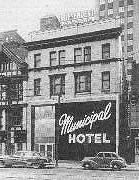
The Chamber of Commerce
|
Toronto's gay scene,
pre-1960
David Churchill:
James Egan
Includes photos of many of the venues noted here. Egan, a one man gay movement in the '50s, was largely forgotten until research in the '80s on local "trash" tabloids uncovered letters he wrote to them. By the '90s he & lover Jack Nesbit would be famous -- as a ground breaking human rights case before the Supreme Court of Canada.
Coming Out in a Cold Climate: A History of Gay Men in Toronto during the 1950s (Masters thesis, 1993, available at the Ontario Institute for Studies in Education).
(compiled & edited by
Don McLeod):
Challenging the Conspiracy of Silence: My Life as a Canadian Gay Activist. Canadian Lesbian & Gay Archives & Homewood Books, Toronto, 1998.
For details see Homewook Books.
Sara Ellen Dunlop
Best known in the '60s as mother of The Music Room & The Melody Room, Sara Ellen later had another career, in women's music. She founded Homemade Records, Canada's first production company devoted solely to female artists, & the band Mama Quilla. In the early '80s it was recalled in the name of a popular women's rock group, Mama Quilla II (see 1982: Jan - May 30).
Sara Ellen died of cancer in Feb 1978. She, & the scene she once fostered, were evoked by John Forbes in Issue 41 of The Body Politic. He'd last seen her two years before:
"For a second we were back in the Music Room, circa 1963, gliding past queens in their puffy mohair sweaters, white levis & bouffant hair; butches in trousers & Elvis ducktails; dragshows with Riki Tik, Alberta, Toni Seven, Jamie Durette, Johnny Day, camping it up to the Ronettes, the Supremes, Martha & the Vandellas.
"The Music Room was our club, a focus of our community. None of us ever dreamed that one day there would be gay pride, gay liberation, that what I recall of those days would so often be called sexist. But those bars & clubs were still a centre, a rallying point, a community on which to build the gay groups we have today."
The Parkside
& The St Charles
Gerald Hannon:
"Epitaph for the Parkside." TBP, Apr 1980.
In fact, epitaph for cops spying on the cans (their hidey hole shown in photos); The PS had six years of life yet left. This offers a concise history of the joint & The St Charles, with bits on earlier homo haunts.
Gay downtown
The 4,700 apartments noted above -- & their mostly young, single, childless tenants -- were all within Census Tract 63, bordered by Yonge, Bloor, Jarvis & Carlton. More were nearby in tracts just east: to Sherbourne; &, south of Wellesley, to Parliament.
While heavily gay populated in 1971 (even before), this area took years to become a visibly gay neighbourhood. Tract 63, Church & Wellesley its main intersection, is now blatantly "gay downtown" -- but might not have been. It's the product of a fine balance between intense highrise development & its later control, preserving the life of the street.
For demographic highlights, see a note in 1992: Jan - Jun. For fuller details: Time & Place: Toronto 1971 on the CLGA site. That document includes a walking tour of the area in 1971 (when there wasn't much to see), links to demographic & development data, 1951 - 1991, & photos of key sites taken in 1997.
Toronto's Church & Wellesley
Spadina
Rosemary Donegan
His son Robert Baldwin would make an even greater, if rarely celebrated, contribution to Canada: responsible government -- for which see an addendum on Canada's odd history: Loser (who sometimes win).
Spadina Ave, & Kensington Market just to its west, have been the city's classic "immigrant staging area" for well over a century, its population ever shifting: Jewish; Portuguese; Hungarian; now Chinese & Vietnamese -- though with each wave leaving behind some sign of its culture. It is one of Toronto's most vibrant streets.
For years the main source of work around Spadina was the needle trade, its huge factory lofts, many with grand towers, landmarks of the neighbourhood. For the edification of tourists the city has given the area (& others) distinctive street signs, the ones here reading "Fashion District." "Garment District" would be more apt: this is where "fashion" is made -- but rarely where it's worn.
(Introduction by Rick Salutin):
Spadina Avenue. Douglas & McIntyre, 1985.
Spadina's generous width (second only to the ceremonial, median divided University Ave) grew from literal generosity & attempted ceremony dating from 1813. It was laid out 132 feet wide -- twice the usual, later widened further -- as the road from the Town of York (as Toronto then was, its northern boundary at Queen St), to Dr William Warren Baldwin's house -- Spadina -- a native word for a sudden rise of land, & on such it stood, not far from a later confection, Casa Loma. In time Baldwin made his grand avenue a gift to the city.
The Music Room had been at 575 Yonge since 1962 -- partner to The Melody Room at 457 Church, both run by the indomitable Sara Ellen Dunlop who, as a regular there would later recall, had no qualms about kicking rowdy het creeps "ass over tea kettle down the stairs."
But both were after hours clubs serving no booze. There was The Pink Pussy of course, but the main "circuit" was and had been for years much farther south, running along Queen from Yonge to just west of Bay, with a few outposts on King Street east of Yonge and farther north around Bloor and Avenue Road.
From the late 1940s local gay men had known the intersection of Queen and Bay as "The Corners," a place where they could surely find each other at the taverns in the Municipal and the Union House hotels, just across Queen from where the gleaming new city hall would stand by 1965. Bowles Lunch was right at The Corners, its basement counter (and washrooms) open all night.
Just up Yonge were the Rio, Coronet, and Biltmore theatres, where assignations could be made in the back rows -- as they had been made in downtown theatres since the beginning of the century and likely before.
The beverage room at the Savarin, down Bay from Queen, was a popular spot. On Bay a block north of Queen was the huge, grimy Ford Hotel, the bus station across the street as cruisy as bus depots long have been most everywhere. The Continental Hotel was nearby, smaller, its tavern one of the few places women, mostly lesbians, went alone.
Over on King East was The King Edward Hotel, very grand, with its Pickwick Room and Times Square Lounge serving a discreet gay clientele, just as the King Cole Room did at the Park Plaza Hotel up on Bloor.
Across King from the King Eddie was Letros, its downstairs Nile Room then the most famous gay venue in the city. With walls done in imitation snake skin, patrons dubbed it "The Snake Pit." Or "The Vile Room."
Letros was well enough known to have been a subject of sociological interest, in an Addiction Research Foundation study called Working Papers on the Tavern. An "informant" had led the investigator on a tour of "The Gay Bar," unnamed but clearly the Nile Room. There among other odd discoveries he learned of the local argot known as "bitching" -- snappy put downs in which, he gathered, anything was allowed but the truth.
With the occasional exception of Letros, none of these places was exclusively gay. Hotel bars had long been a favourite haunt for gay men: liquor laws in Ontario had long made them one of the only places to buy a drink; around the world they offered relative anonymity and a parade of new faces conveniently passing through town.
Yet in hotel taverns and elsewhere, gay customers were usually a minority, if carving out bits of territory for themselves. Even the Municipal, which held a Halloween drag show in 1961, wasn't entirely gay. An earlier liquor inspector's report on it had noted:
- This room seemed to be a meeting place for young men with feminine characteristics and possibly sex perverts. There were at least twelve of this calibre at different tables in the south part [that is, the back] of the room.
Nor were these places the great democratic melting pots that gay venues were sometimes reputed to be. In Coming Out in a Cold Climate, David Churchill noted distinct class differences.
Working men's pubs had long had gay patrons but, as in most places, usually off in their own corner. George Hislop recalls the Municipal and the Union as "The Chamber of Commerce" and "The Board of Trade" -- not only for their proximity to the Bay Street financial district, but for hustlers doing business there.
In contrast, Letros (even if "vile") was rather an upscale place, the Times Square Lounge across the street even more so. In Lynne Fernie and Aerlyn Weissman's film Forbidden Love, on lesbian life in the '50s, one woman recalled going there with gay men: "My, they were good lookin' fellahs. And you dressed -- pearls, high heels, the works." She meant the women; the men wore suits, even tuxedos.
Such distinctions were not lost on gay people, whatever their class. In 1952 a local tabloid called The Rocket reported in a campy column not rare for such tabs at the time:
- TWO TRADE NUMBERS walked in ... surveyed the establishment ... and decided the clientele was TOO HIGH CLASS, walked out, bowed low (paying homage) to the K.E. [the King Edward], then scurried on to BOWLES!!
No one but the older inhabitants of The Parkside or St Charles knew any of this history. All these places were long gone but for Letros, open until 1972. It would be years before people like David Churchill or Toronto's Foolscap Oral History Project coaxed stories out of the old timers and dug in historical records -- police files, LCBO reports, and trash tabloids among them.
But class distinctions survived. Even between those two grubby gay bars on Yonge Street, one, The St Charles, was seen as more low life and sleazy than the other. The Parkside was hardly The Ritz -- we butted our cigarettes on the floor there -- but among its mix were a few more middle class types.
The Parkside also had distinct turfs, much like the ones gay people had claimed in otherwise straight venues. Here we were all gay but with varied interests, occupying various neighbourhoods: the leather and denim alley along the south wall's frosted windows; "The Drugstore" under the TV on the north.
In less firmly defined space flanking the middle aisle you might find a few tables pulled together, budding gay activists and those willing to hear them all yakking away, accompanied by the bass beat of the jukebox.
It would be some time before there were bars catering to more specialized tastes, breaking up The Parkside's crowd into many distinct ones. But then, there, you could meet anyone from dapper gents out from behind the counters at Eaton's, to actors fresh from stage, to kids who worked the streets.
Those last were few, at least if their trade became known: Big Frank, a huge waiter, grim until he got to know you, was expert at manhandling them out the door in a flash.
Big Frank was also good at breaking up fights. There were few of those, too, but every few weeks or so you could count on a brawl briefly clearing a good patch of floor, chairs crashing back, men standing on some still upright.
One stood on his chair more often. Jackie, a well preserved older gent with a dyed black coif, would regularly climb up and regale us with the opening bars of "I'd Rather be Blue." He'd then calmly get back down to his beer and his usual confreres, all of them, always, at the very same table.
By March my life just up Yonge Street, at The Book Cellar, was coming apart. Randy and Barbara had quit and the jerk manager of the Yorkville store had taken over. As its most senior staff member by then, a whole raft of familiar faces having quit, I was named his assistant.
But I wasn't going to be his bumboy. I started looking for a new job and before the end of the month I found one, shelving books in the ancient stacks of the University of Toronto's Science and Medicine Library. It was part time and boring but I didn't mind that, thinking I'd be free to occupy my mind elsewhere.
I didn't much. A full time job came open in June: I applied and got it. Two years later I'd be running those stacks and their circulation department, managing about two dozen people. The man who held that supervisor's job when I first arrived was named John, white haired, red faced and English. His occasional martinet manner covered a wicked sense of humour, his bright nose likely coloured by too many drinks at Letros.
In time we were camping it up. Once in the stacks, giggling over boys, he heard someone coming and snapped, "Butch it up, Mary!" At the checkout counter one day I commented on a tight jeaned courier. "Who was that?" I asked John. His casual reply: "Princess Margaret." After a beat we both cracked up. The kid had been picking up books for the Princess Margaret Hospital.
John was not the only gay man at Sci Med, as we called it. We were many, ending up billed as the entourage to a wonderful woman named Helaine, close to retirement but always dazzling, a former showgirl. She dubbed our workday routine "When They Were Gay and She Was Ninety."
Bob, a fellow worker who would become a good friend, made his status plain when once, after clearing his throat, he shot me a grin and said, "Hmm! Must be last night's trick!"
Bob studied Egyptology and in class had met Dan, a student from Winnipeg. Dan also ended up working with us. He was hugely handsome, his shirts and pants in the style of the day tight to a chest that might have been armour plate and a bottom literally stunning. Bob had got him to bed once or twice; Dan was also dating a woman. He and I became friends, too; we'd sit in The Parkside together, he always quiet, as if pondering his fate.
Dan would marry that woman and then get divorced. I'd have dinner with him in Winnipeg in 1974, an odd, touchingly romantic moment. I'd see him again in 1990, back in Toronto, very much a weary middle aged man by then, his one love his sailboat. He'd spend much of his time on it, alone.
There were boys at the library less ambiguous than Dan -- straight boys. Straight women too, strong smart ones: in Sci Med management meetings I'd be the only man in the room -- though the higher one looked in the ranks, the more men one found. None that I knew of was lesbian, if none not clued in about gay people. When Bruce Arnold, a languid Saluki of a boy working in Reference, overdosed on Sopors after a night at The Manatee, Sci Med librarians and I went all the way to Barrie for his funeral.
The straight boys were clued in too, if in varied ways. Some were comfortable, even sweet. But a few could be a bit wary, macho in compensation. Even they weren't bad: libraries don't attract jock jerks. And some were nice to look at.
But they were more prone to be sullen about their work, and their bosses. When the head of Reader Services (one of the library's two overarching divisions) happened to stroll through I'd sense a buzz in them, part fear, part bravado. Most of the gay men didn't react that way. To us head honcho Herb was just another queen, a bit pretentious but all right, really.
Gay men can undress men (even those straight boys) on sight, male armour of any sort a screen we easily see through.
|
Comrades arm-in-arm
"Season's greetings from
Filmmaking duo Bozo Moyle (left) & Frank Vitale were likely at the Moyles' home in the west island burbs for this early '70s shot -- olives on sandwiches (not to mention the decor) far from life on The Main. A review of their 1974 Montreal Main in TBP would say "this really is the Montreal of a group of real people, & not even the cups have been washed for the occasion." |
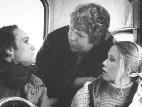
Diva in mufti:
|
At The 511, Craig Russell (then just "Craig") said of our vaguely hippie crew: "You're not the usual crowd." It seemed a compliment.
He was more often called Bozo, at the centre of a zany crowd who all lived along St Lawrence Boulevard, more often called The Main. Their scene was sexually ambiguous, many of them gay, Bozo not but full of physical energy and affection lavished on friends of every gender and sexual orientation. Walking down any street, Bozo would always have an arm thrown over somebody.
On my trip I stayed with his loft mate Frank Vitale. He and Bozo would later immortalize their crowd in films, Montreal Main in 1974 and The Rubber Gun in 1977. Bozo went on to Hollywood, directing Times Square and Pump Up the Volume.
I didn't find Bozo on that trip; he was out of town. He later told Joel, "If you see Ricky, give him a slap in the face for me."
A few months later Joel asked if he could pick me up at work for lunch. I met him outside on the steps -- and there with him was Bozo. He jumped up and gave me a huge hug. I thought: if only more gay men, or for that matter even straight ones, could be as comfortably engaging as Bozo.
- Sunday, May 30, 1971, 8:10 pm:
On Thursday night I went with Flav, John, and Jane and Michael and Peter (from upstairs at Flav's) to the Club 511 to see a drag show. I forget the person's stage name (his real name is Craig), but he was good, doing Carol Channing, Peggy Lee (very good) and Barbra Streisand. We talked with him later, and I was genuinely surprised at how much I liked him.
We went again on Friday night, this time to see Peter perform. It was a big show, five girls (?) counting the emcee, who made a few valiant attempts at catty jokes. His name was Toni; he's apparently been around for quite a long time. For Peter's first appearance Toni said: "Peter wants to dedicate this number to some of his friends. Are they in town, PJ? Oh! They're in town! You live with them? Are they cute?" And from the audience: "They're beautiful!"
The record was bad, Peter was not pleased. His next number, from Cabaret, went off very well. Afterwards I met again a boy named Ken, who was debuting as Renée the next night. He was very cute. I danced two or three slow numbers with him. Peter later said that he asked a lot of questions about me. We all danced a lot. During a fast dance Jane squealed. I asked, "What's wrong?" "You're turning me on!" "Jane!" I said, "we can't go on meeting like this!"
It's very strange and fun going anywhere with Flav. We seem to feel a liberating duty to turn everyone's head around a little, and we usually do. The 511, Craig said, doesn't see many like us. "You're not the usual crowd." It was a pleasing compliment.
Peter lip synched his numbers that night. Craig did not. His full name was Russell Craig Eadie, later famous as Craig Russell. Gay filmmaker Richard Benner would do two movies starring him, Outrageous! in 1977 and in 1987 Too Outrageous!
Both would be fictionalized versions of Craig's own career, and his relationship with Margaret Gibson; her book The Butterfly Ward, based on her experiences in a mental hospital, provided the subtext in both films. Bozo Moyle had a small role in the first one, playing an escapee from the loony bin.
The 511 was in a basement, at 511A Yonge. Craig was right that we were not its usual crowd, more outrageous ourselves than anyone there but the drag queens. But our "liberating duty" came from no coherent politics of liberation. It was merely a matter of personal style, a counterculture hangover from the '60s -- too often complete with that decade's evangelical self righteousness.
It could be a bit much. Even for me.
|
Pride (unofficially)
Homos on the beach:
|
Pride (later on)
Toronto's Gay Pride Week 1972, featured in the centre spread of TBP Issue 6, ran from Aug 19 to 26, with art shows, panels, a march of 200 to Queen's Park -- & another Hanlan's Point picnic.
In 1973 Gay Pride Week went national, with events (some small) in seven Canadian cities. Toronto saw another Gay Pride March in Aug 1974. There were more summer demos after that, but not another big festival until Gaydays (see 1978).
After Toronto's big bath raids (see 1981), Lesbian & Gay Pride Day was resurrected, held in late June to coincide with international (mainly US) fests marking New York's 1969 Stonewall riots. And thus it's ever been, local history before 1981 often forgot.
In Jun 1999 I wrote The Globe & Mail complaining that they (in fact all local media) reported Toronto "first Gay Pride event" as 1981's. I sent coverage of '70s fests. My letter didn't run. When I asked why an editor wrote: "I had not planned to run your letter because it seemed like more an issue of semantics than history. The Globe referred to 1981 as being the first official, capital- letter Gay Pride Parade."
Thus is history rewritten -- as "official" history.
The Aug 28, 1971 Ottawa demo & "We Demand"
Background on the demo, the full manifesto -- & chronologies of what came of those demands up to 1997 -- are in & leading from We Demand, on the CLGA site.
On Sunday, August 1, we all went to a big gay picnic at Hanlan's Point on Toronto Island. I'd later think of this as the city's first gay pride event but it wasn't, at least in name.
"Gay Pride" would be adopted in 1972 for celebrations held then and for the next few years, always in August to mark Canada's decriminalization of homosexuality on August 26, 1969. People often said then that homosex had been "legalized." George Hislop among others took pains to point out that that wasn't true.
"Homosexuality" had not been illegal: the word wasn't even in the Criminal Code. Its operative terms were "buggery" and "gross indecency" (the latter outlawed undefined acts between "any male person" and "another male person") -- still there then, and still crimes unless committed by two and only two persons 21 or older, and in private. Cops still had ways to get anyone underage, in a park or a loo, even in their own bedroom if any third party, in or out of that room, witnessed their act.
A few weeks after that picnic, some 150 homosexual men and women would gather on Parliament Hill in Ottawa to claim their full rights as citizens. It was the first major gay demonstration ever held in Canada. The manifesto read out loud that day was called "We Demand."
But on August 1 we were just having a party. Lots of people were there, some I knew, wondrous Fernando among them; many more I didn't know until that day. We hitched up with Bill, a handsome man, 34 years old and unhappy with the fact. To me he was lovely just as he was. To Flav and John he was a candidate for liberation. I wrote about a visit we had 10 days later with him and his equally attractive lover Murray:
-
Flav and John spent a great deal of time playing Pygmalion on Bill. Before we do anything, Bill, we have to teach you how to relax. Whiteface will be good for you, it's good therapy, Bill, you need it, etc, etc. "I'm ready for something new," he said, "I'm tired of the person I am now."
Murray looked at me with a kind of "Get this" face, tilting his head toward Bill. He's just too gullible, and Flav and John are not ones to pass up the opportunity to do a little remoulding in their own form. Being the third party in this can be a pain in the ass.
Whiteface makeup was our theme routine. It was good therapy: behind a mask, even if one only painted on your skin, you could risk things your fully exposed self could not.
And as men it taught us something most women (and every drag queen) knew well, by convention or by choice: that you could know your own face -- study it, reshape it, play with it, literally constructing a visage to take out into the world. I loved it. I'd keep talismanic sticks of greasepaint long after I last wore any.
In 1972 we'd make a film with Stanley Kochen, Paul Reuber and lots of other friends, a gorgeous but not gay man named Michael Mitchell directing. It was a Pied Piper motif, Flav playing piper.
People he met suddenly popped out in whiteface like his, as he led them to gather more glum types and make them gay -- in the old fashioned sense of the word. I was the first disciple, found on the subway holding up to my face a copy of Maclean's with Pierre Trudeau's mug life size on the cover. When I lowered it, voila! -- there I was all slapped up in red on white.
Much of Yonge Street was closed this year to make it a summer pedestrian mall. We dragged Bill and Murray out into it, all of us made up and in odd costumes; I'd got to straddle a shirtless Bill, painting his beard green. We danced, banged on oil drums set out in the street, did mime skits off the cuff.
We met another troupe done up in Arthurian fairy tale garb (it was that kind of time) and did a few bits with them. A British tourist told Bill she found him very handsome. We were a hit.
But I came to like better spending time alone with Bill and Murray, finding out who these lovely men were. We took long walks, sat yakking at The Parkside. I last saw Bill a while ago, still crabbing about his age if perhaps with better excuse, over 60 by now. But he still looks great. Murray died some years ago.
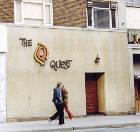
Dress up, stand up:
|
In time those four were just one. He sold the business to Phil Stein, a straight Forest Hill neighbour of Norm Bolter, who told him the place would make pots of money. It did. "I look at the facts and figures, nothing else," Stein once said; he was soon and aptly known as "Philistine." But he did manage to make a gay bar quite unlike the two down the street.
The front was entirely refaced in light brown stucco, beige very in at the time, the door, the bar's name and a big "Q" the only things visible from the street. There was a dress code: no jeans.
On the main floor was a pleasant bar. Upstairs was a dance club, painted a rich blue when I first saw it, lit by an orange neon swirl curving across the ceiling from one end to the other. (That fixture would later be dead, as I recall; the place painted black.) There was a smaller bar upstairs, a stand up one.
The Quest was the first place I ever saw anyone -- in fact everyone -- standing up and walking around with a drink.
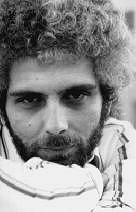
Catholic kitsch;
|
Missionary impositions?
Later in life Alvyn returned to his roots (if not uncritically), writing books: Aimee Semple McPherson, his biography of America's Canadian-born evangelist star, was published in 1980 by Fitzhenry & Whiteside. In 1986 the University of Toronto Press released his Saving China: Canadian Missionaries in the Middle Kingdom, 1888-1959 -- years encompassing his parents' career & his birth (if in India) in 1945.
Last seen in June 2003, Alyvn was teaching at Brock University.
Zap!
For more on the "zap" tactics of the early gay liberation movement, its politics of "polymorphous perversity" -- & their critics, urging more concrete if conventional efforts to reform human rights laws -- see History: As history.
For Michael Pearl, Paul Macdonald, other key activists of the day -- & one big thing they achieved -- see On the Origin of The Body Politic.
Born in India of Baptist missionaries but since of no divine calling, Alvyn was a collector of Catholic kitsch. He studied museology, expert on the stained glass that filled the city's Victorian houses.
He later moved to Cabbagetown, sharing a small house with three other guys; it was a wonderful menage. Peter and Cecil were waiters at The Old Spaghetti Factory -- "The Spag Fag" as they called it. (Both would go on to other careers, Cecil in time an AIDS activist.)
Terry was a jeweller, as was Bill, a regular visitor, both working for Victor Secrett, one of those four men who first opened The Quest, his store the city's most upscale bijouterie. (Victor later died but his business did not. Terry would run the place -- Bijou Terry indeed -- in his off hours working on gala AIDS benefits.)
Alvyn, Cecil, Peter and I went to a party on September 17. We found George Hislop there, along with a few others trying to take gay politics beyond mere lifestyle. As I recorded in my journal, they did not find a receptive audience.
-
A few of us got into a discussion of gay lib. There was a standard brand oppressive radical wearing a bright orange patterned dashiki. He got quite a lot of opposition from some of the more dressed gays, who perhaps saw him as more oppressive than straight sexism, with which they have learned to cope.
My position, as usual, was somewhat in between. Gay people do need to be liberated in a number of ways. (Perhaps primarily from their emphasis on appearances, which leads to all the clothes and hair trips, among the biggest rip offs around.)
But liberation from straight sexism will not be won through zap ins, as far as I can see. Zap ins are all in keeping with radical kharma [sic]: they make you feel good and sometimes a little naughty while you're doing them, but their net effect is usually only further repression.
Zap ins (or just "zaps") consisted of a few gay people making their sexual orientation plain in places where it wasn't likely to be welcome. Straight bars were a favourite target: men would dance together, a few women too, get thrown out and call it a victory.
The day after that party Alvyn and I ran into a more public zap, a handful of men in front of city hall, hand in hand. Among them was Michael Pearl, his hands clutched by two others, one of them Paul Macdonald -- that "standard brand oppressive radical" of the night before. I said they were cheating: two might be PDA -- public display of affection -- but three was just guys goofing off. It was so stiff, contrived: I thought of Bozo's easy public affection in contrast.
Alvyn and I were not holding hands. Michael called us closet queens. Alvyn shot back: "I'd have brought my closet with me, but the casters squeak." I threw my arm over his shoulder and we hung around with that lot. For a while.
In September we added Bill Rowe -- who signed his works Willyum -- to our ever growing circle. An artist in Brooklyn, he had been corresponding with Flav and sending samples of his work, precise, pointillist and very zany. Postal art was big then: I have fat files of cards decorated by Bill.
He came up for a visit and we met him at the bus station. He was impossible to miss, in a jacket covered with bangles and patches, Frankie Avalon on one shoulder, a maple leaf blaring "Canada" on the other and too many more for me to remember. Bill took to multi coloured fright wigs, longjohns with no pants and big yellow gum boots -- all worn in public.
Later he'd come to stay for quite a while, accepted as a permanent resident of Canada. We'd meet him at the airport in whiteface, a red carpet rolled out, a big Canadian flag madly waved and draped over his shoulders. Even the Customs officers liked that.
|
Joint Halloween débuts
The Body Politic's Issue 1;
|
Before our brainstorm over Union Station, one had broken out just down Huron, in the basement of a counterculture community hall. A handful of homos, some those refugees from Guerilla, had decided to start their own paper.
My occasional irritations with Flav and John's routines were no more than the usual grinding among good friends whose gears sometimes mesh too close. But that closeness was also a source of confidence, even inspiration. We believed we could do anything. And sometimes it was true.
-
Saturday, October 23, 1971, 5:40 pm:
Brainstorm of the week: a book on Union Station. Mainly a history with photos, or maybe a photo essay with historical commentary. The balance, I guess, will work itself out, depending on how the research goes. John wants to do the photos. I've already done a little looking for information and things are coming up slowly.
I don't know who would be interested in publishing it. We will be in touch with the Architectural Conservancy of Ontario, who are working to save the station, and they may be some help to us, as we may be to them in the long run.
Union Station, built from 1915 to 1919 in grand Beaux Arts style, was one of the finest structures in the city. It stretched 750 feet along the south side of Front Street, massive pillars marking its ticket lobby -- though that term hardly did the space justice. It was the biggest public room in Canada, it ceiling 88 feet high.
But the land it sat on was coveted by Metro Centre, a vast project meant to include the world's tallest communications tower. This town was desperate to be modern, "World Class" a touted term. Earlier we had nearly lost our grand Romanesque Old City Hall, dating from 1889, to a shopping mall.
The promo model of Metro Centre looked impressive -- until one looked closely: Union Station wasn't there. There was a new rail terminal farther south, small and low, where -- as Ada Louise Huxtable had said of a similar facility that replaced the palace of New York's Pennsylvania Station in 1965 -- one would no longer "enter the city like a king, but scurry in like a rat."
Huxtable called that "urbicide," Toronto about to commit it: our own grand gate to the city was to be smashed to rubble, replaced by six mediocre office towers. Old City Hall had been barely saved by a coalition of citizens intent on preservation. Now they had turned their efforts to saving the station.
That book would actually come to be, in an effort much bigger than we first dreamt. John clambered all over the building, down in its bowels and up on its roof, even shooting out in the train sheds and rail yards. His work was done early on; mine would take much longer.
We did find someone interested in publishing it: Peter Martin Associates. I'd met Peter and his wife (and co- publisher) Carol at The Book Cellar. And we found other collaborators. One got the provincial arts council to grant funding. Another provided historical photos. Still others wrote chapters on the station's social and railway history, its architecture, and its potential for the future of this city. Two poets offered works, one doing an original "found poem" based on signs in and on the station.
They all did it for a $100 honorarium (John and I got $200), royalties beyond benefitting the Committee to Save Union Station. The book would be published to critical acclaim if not, for Peter and Carol, great financial success. (In 1982 I'd get thanks from the Architectual Conservancy, successor to the committee, for their final cut: $765.68. PMA had by then gone bust. Union Station stands to this day, though shifting realty values likely had more to do with that than a book. West of it we did get that "world's tallest" erection: the CN Tower, finished in 1976, poking up 1,815 feet into the sky.)
But it would be December 1972 before we saw that book in print. Just weeks before our brainstorm another had broken out not far down Huron Street. In the cellar of a counterculture community hall there a handful of gay people, some of them those refugees from Guerilla, decided to start their own paper.
Their work would go much faster than ours. That paper would hit the streets less than two months after it was conceived.
On Halloween we slapped up again and went out to Yonge Street. I'd painted my face as a skull, wore Flav's grand black cape and a top hat (bought the day before; I still have it), my hair, down to my shoulders then, sweeping out beneath. A well dressed lady came along and said she like my makeup. I said I liked hers, too.
Real drag queens were in their traditional flight from The Parkside to The St Charles, a mob across the street heckling them. Among that crowd I saw a few people I knew, passing out a flyer headed "Take off Your Masks." Comrades were hawking that new gay paper. They'd called it The Body Politic.
I would soon get a copy, later issues as well, in fact every one of them. (I still have all of those, too.) But I had no idea then what that little paper would come to mean in my life.

Surprise (non) visit:
|
Still, I did know then that I had a life, moving out in the world as a gay man. At the end of the year I flipped back through my journal and made a list of everyone I had met, just in 1971. I covered a full page and beyond, naming more than 140 people. "My dear," I wrote, "you should keep a card catalogue!"
There was at least one more person on my horizon. I had gone to visit my family for American Thanksgiving, getting a lift down with a friend, Norman White, who did electronic sculptures. When I got back Flav gave me a picture of a man -- sitting in my apartment. He had a key and had taken him there: a dancer with Montreal's Les Grands Ballets Canadiens; they had been in town on tour.
It was Vincent Warren. Vincent -- for whom Frank O'Hara had written those love poems. In time we would meet and I would know why he inspired such lyricism.
I would be in love myself. Not with Vincent, really, wonderful as he was. I was in love with my life.
Go on to 1972
Go back to: Contents page / My Home Page
This page: http://www.rbebout.com/bar/1971.htm
December 1999 / Last revised: July 10, 2003
Rick Bébout © 1999-2003 /
rick@rbebout.com

